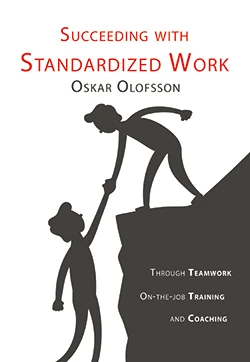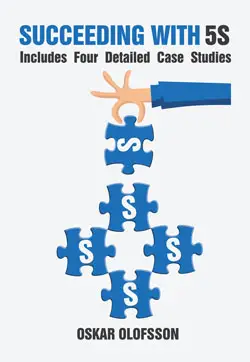
Lean manufacturing is a management philosophy inspired by the Kaizen concept. The aim is to improve a company's profitability by improving quality and reducing costs.
In short, the concept consists of a range of tools which reduce wastage in production. Waste is anything we do that the customer is not willing to pay for. Simply put, it's everything that makes us run around, and that introduces stress and strain at work. This could typically be caused by:
In order to successfully introduce and develop lean requires the introduction of "lean culture" into the company. This will ensure that it works long term and towards common goals.
The following five headings are a summary of the areas which currently comprise the lean concept. If you wish to evaluate how your organization compares, I suggest that you try our self-evaluation test (see the link below).
The first step of the journey is often an investment in quality. Stable processes with low levels of variation and solid product design reduce wastage caused by scrap, rework and/or unnecessary stock reserves. The tools we use in the quality process are:
Jidoka – a methodology where quality control is automated and built into the methods of working and the machines. This implies automated inspection of all products. Jidoka differs from traditional quality control – which occurs after the event, when it is no longer possible to correct the process.
Poka Yoke – this refers to processes which are designed to avoid the possibility of making mistakes. i.e. a "mistake-proof" process!
Quality tools for problem solving and optimization such as root cause analysis and statistical methods. Here, Six Sigma methodology can be integrated into Lean. The result is usually referred to as Lean Six Sigma.
Standard Operating Procedures – This means agreement on a standard method of performing all repetitive tasks and then carrying out what has been agreed. By adhering to a standard we reduce any variations in quality and cycle times and the task of improvement can begin.
Risk analysis using the FMEA method – This is a way we can systematically examine the risks in a process, assess how critical they are and decide on any action/s required. For example, risk analyses can be performed on quality defects, health and safety, malfunction or the risk of the project.
Once the level of quality has been stabilized, the next step is to control how much to produce at any given time. This is particularly effective when the production process has intermittent over-capacity in relation to market demand.
Just-In-Time does not mean the ability to deliver everything the customer needs at all times. Instead, the aims of lean are to be able to respond to fluctuating demand with a reasonable delivery policy, buffers and a smooth rate of production.
Tools to achieve just-in-time are:
Pull production and the Kanban system - this means that production takes place to meet a genuine need and only if the next stage in the process can receive the goods. Consider how new burgers are only assembled at a fast food outlet when the level of ready-made hamburgers has reached a certain level. New hamburger buns are then thawed when the number of thawed buns falls below a certain level.
Balanced lines and Takt - this means that the workload and cycle times of each operation are equalized so that bottlenecks and overproduction do not occur. Production speed is adjusted to meet the average actual customer demand. By dividing the product into groups, the mix of part-manufactured product groups per day can be adjusted to achieve a smooth workload. This is called Heijunka.
The use of buffers to handle fluctuations
SMED methodology - a way to shorten change-over times which allows for smaller series
The measures primarily aimed at increasing productivity can also be found in the TPM concept. These actions are most effective in capital-intensive organizations and where equipment creates a bottleneck. Included under productivity are:
OEE- measurement to measure and improve the reliability of the production equipment
5S to maintain order. Maintaining cleanliness and conducting regular inspections increase efficiency
Autonomous Maintenance -Operators takes better care of their machinery in on organized way for higher reliability
Kaizen means continuous improvement. This forms the very foundation of the concept and the tools that are used today have been refined over more than 50 years and are continually improved upon. Of course the existing tools can be copied but they need to be adapted and individually developed in order to achieve lasting results. Aids to assist in achieving continuous improvement are:
Kaizen - Systematic efforts to improve
Follow-up, monitoring and visualization – Visual Management System (VMS)
It is often said that thinking is the most important aspect of Lean. If we introduce the methodology in the right way, an understanding for lean is built up in the organization as and when the chosen tools are implemented. However, this requires, among other things, that the introduction includes sufficient training and time for reflection, and gives employees an opportunity to influence their own situation. A learning organization is characterized by:
A modern and consistent leadership with a long-term perspective. Leaders who ensure that all standards are adhered to but simultaneously encourage their evolution.
Ensuring that the lean concept includes suppliers, customers as well as support functions and other departments such as product development and the projects department.
The existence of common goals throughout the whole organization to avoid mediocrity OK!
The systematic use of deviations to see problems and achieve improvements.
For the successful introduction of lean, three things in particular are required: commitment from management, the necessary resources for the implementation and sufficient knowledge throughout the organization.
Top management's most important task in the lean process is to set challenging goals and provide resources. They also need to be somewhat stubborn, and to think long-term.
The process of change will eventually be driven independently by the managers in the organization and not by consultants or specialists.
Consultant support and training will be geared towards helping management and key line personnel to introduce the changes.
Considerable consultant support is often required in the initial stages but the final objective should be for the process to become self-sustaining.
Management get support from individuals who are often referred to as coordinators. The contribution of these coordinators is in the form of advice on methodology, visualization and planning, but they should not bear the responsibility for the introduction. This responsibility should always lie with the line managers. Reckon with one coordinator per hundred employees involved in the Lean project. Of course improvements can be introduced without the help of coordinators, but be aware that this could slow down the process and it will place heavy demands on the managers to deal with practicalities during work.
Knowledge of Lean needs to be built up through all the levels of the organization. Management seminars are used to teach understanding to the managers, enabling them to drive performance. Training of staff is needed with the introduction of each tool and to create an understanding of the overall concept.
In addition to the training, knowledge needs to be passed on from an individual who has made the journey himself several times and can help to avoid the serious pitfalls. A consultant, or a very experienced member of the organization, is often called in for this purpose.
By Oskar Olofsson

Making lean work for you

World-Class / Lean Manufacturing

5S Implementation

SMED Quick Change-over

TPM and Plant Maintenance

Succeeding With Standardized Work

Succeeding With 5S